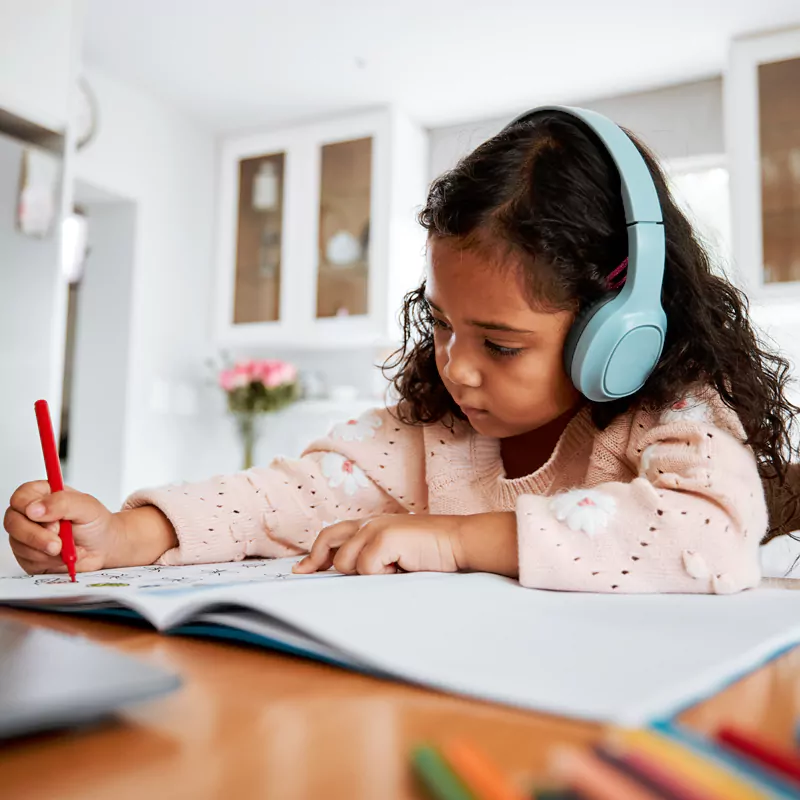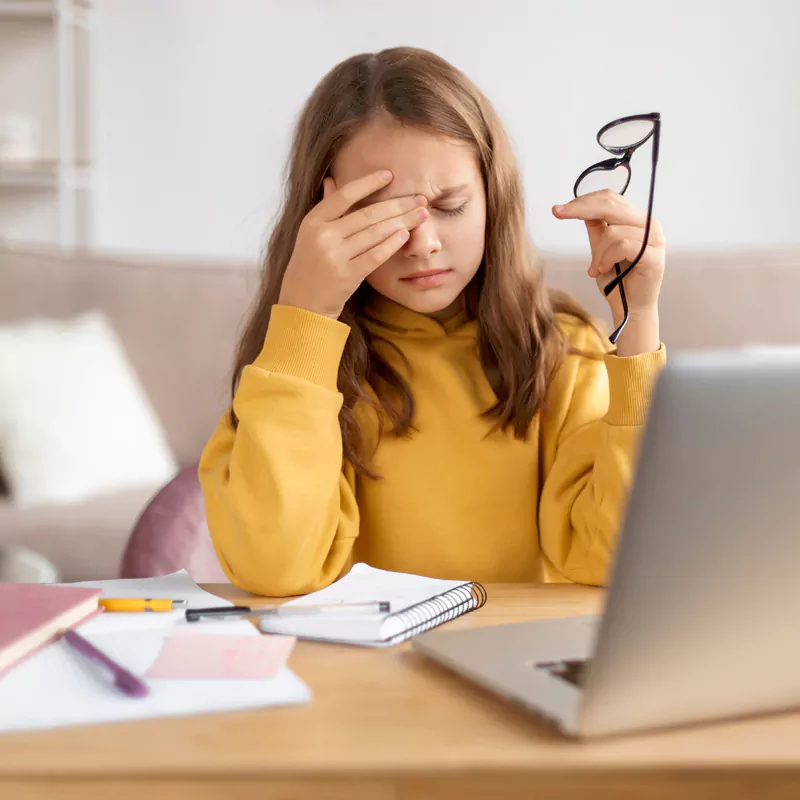Find The Right Balance Between Screen Time And Restful Sleep
Today, more than ever before, entertainment, information, and connectivity are at our fingertips. From streaming our favourite shows to staying updated on social media and the latest news, our smartphones offer a world of possibilities. However, as adults embraced this convenience, so did our children – perhaps even a little too quickly and are spending too much time in front of screens.
According to the Centers for Disease Control & Prevention (CDC), the statistics are startling and might even shock you. And these figures don’t even account for the additional time spent on screens while doing homework!
The CDC reports indicate that young people spend an average of:
- Six hours per day for 8-10-year-olds
- Nine hours per day for 11-14-year-olds
- Seven and a half hours per day for 15-18-year-olds
By being conscious of the connection between excessive screen time and sleep deprivation, you as a parent can take proactive steps to ensure the well-being and development of your child in this tech-savvy world.
Impact of excessive screen time

As parents, it’s also crucial to be aware of the impact of excessive screen time and children’s sleep, health and well-being, as well as their ability to form healthy relationships with family and friends.
Research has indicated a strong link between excessive screen time and various physical and mental health issues in children as well, including obesity, depression, anxiety, and behavioural problems. Moreover, it also hinders adequate sleep, impacting their physical health and academic performance.
Among the most significant consequence of excessive screen time and sleep deprivation is the development of irritability and impatience when it comes to real-world and real-time interactions. Unlike screen time which offers instant gratification, real-life communication requires a sense of presence, patience, listening, and appropriate responses. For example, when you’re playing with your young child, you’re teaching her how to interact with her entire being and the environment.
Human interaction provides benefits that screens cannot replicate. When children engage in face-to-face interactions, they get to use multiple senses, such as listening, touching, and smelling, which lay the foundation for healthy relationships and friendships as they grow older.
So, when electronic screens have become so much a part of our culture, how can parents set boundaries for their children from an early age? And what are the recommended time limits for screen use?
Paediatricians and experts suggest the following guidelines:
- Zero screen time for children under 2 years old. Video chatting with family or friends is permitted
- No more than one hour per day for children aged 2-5 years old. Co-viewing with a parent or sibling needs to be strictly followed
Generally no more than two hours per day for children aged 5-17 years old. This excludes the time for homework
Increasing screen time also leads to insomnia
The increasing use of screens in bedrooms has led to a rise in insomnia among children and young people. In a large American sleep survey done in 2013, 77% of adolescents reported sleep difficulties, such as trouble falling asleep and waking up at night.
Research has consistently shown a link between screen time and insomnia in young children. Several key findings include:
- Using screens in the hour before bedtime leads to less overall sleep and a longer time to fall asleep
- Frequent interruptions from screen devices, like social media messages or notifications, lead to night waking and daytime exhaustion
- Having multiple screens in the bedroom increases the likelihood of experiencing insomnia
The effects of screen time and sleep deprivation, are influenced by various factors, including the type of content being viewed, the level of interactivity, and the light emitted by the screens.
Behavioural Delay of Sleep: One common effect of excessive screen time, especially in the evening, is the delay of sleep onset. Children and young people may prolong their screen entertainment and stay awake later, leading to a reduction in total hours of sleep on weekdays.
Psychological Stimulation: Interactive and psychologically stimulating screen time can have a more detrimental impact on sleep compared to passive forms of screen time. Engaging in exciting and mentally stimulating activities, such as playing violent video games, can increase physiological arousal, making it difficult for children to wind down and fall asleep.
Light-Emitting Screens: The light emitted by screens, especially short-wavelength blue light, can suppress the natural production of melatonin, a hormone that regulates sleep-wake cycles. Exposure to this type of light before bedtime can disrupt the body’s internal clock and make it harder to fall asleep.
Impact on REM Sleep: REM sleep is a crucial stage of the sleep cycle associated with dreaming and overall sleep quality. Studies have suggested that engaging in stimulating screen activities, such as playing video games, shortly before attempting to sleep, can lead to reduced rapid eye movement (REM) sleep.
Maintaining sleep hygiene

To improve sleep and mitigate the negative effects of screen time on sleep, encourage children and young people to stop using screens (including phones, tablets, computers, and TVs at least one to two hours before bedtime.
Practising calming bedtime exercises, such as reading a book, having a warm bath, or listening to soothing music, will help the mind and body to wind down.
Reducing screen brightness and blue light emission has a positive effect. Many devices now offer “night mode” or blue-light-filtering options. Use these settings in the evening to reduce the impact of blue light on melatonin production.
Create a sleep-friendly environment within the bedroom. You can make it conducive to sleep by keeping the room cool, dark, and quiet.
Remember to involve your child in physical activity during the day. Regular exercise helps improve sleep quality and regulate sleep-wake cycles.
Keeping children physically active

Screen time and obesity and lack of fitness in children are interlinked. This is not difficult to figure out, as the more time children spend sitting and staring at a screen, the less time they will have to be active.
The University College London study found less than half (41%) of 14-year-olds met recommended physical activity levels, while only 23% spent two hours or less a day using screens. It was also noted that they ate more high-calorie, low-nutrient fast foods while they were using their screens.
Encouraging physical activity in children can be challenging, but with consistent effort and creativity, parents can help make it an enjoyable and integral part of their daily lives.
Here are some practical tips to improve your child’s physical activity:
Lead by example: Children are more likely to adopt healthy habits if they see their parents or caregivers engaging in physical activity regularly. Be a positive role model by participating in exercise yourself and involving the whole family in active pursuits.
Make it fun: Find physical activities that your child enjoys. It could be playing sports, going for nature walks, dancing, swimming, or even playing active games on the balcony. Making exercise enjoyable will increase her willingness to be active.
Limit screen time: Set reasonable limits on screen time and encourage your child to take breaks from screens. You can create a schedule that includes specific screen time hours and designates the rest for physical activities and other tasks.
Encourage outdoor play: Spending time outdoors provides numerous health benefits for children, including increased physical activity, exposure to sunlight (for vitamin D), and improved mental well-being.
Get involved in sports: Enroll your child in sports or physical activity classes that interest her. Whether it’s soccer, basketball, martial arts, or dance, these activities can be both physically and socially rewarding.
Family activities: Plan regular family outings that involve physical activity, such as hiking, biking, or playing sports together. This promotes both fitness and family bonding.
Walk or bike to school: If possible, encourage your child to walk, bike, or scooter to school instead of driving. This adds more physical activity to her routine and is an excellent way to start the day.
Use activity trackers: Consider using activity trackers or smartwatches that can make physical activity more engaging for children. They can set goals, compete with friends, and track their progress, making it a fun and interactive experience.
Be Supportive and Positive: Praise your child’s efforts and achievements in being physically active. Avoid using exercise as a punishment and focus on creating a positive and supportive environment.
Remember, not all children are created alike, and what is ok for one child may be totally unsuitable for another. So be patient and open to trying out different activities until you find what resonates with your child. The goal is to instil a love for physical activity that will benefit throughout her life.
Excessive screen time leads to vision problems

Screen time, especially prolonged use of digital screens can have significant effects on a child’s vision. Eye health experts have observed that children may experience similar vision-related problems as adults, such as eye discomfort, fatigue, blurred vision, headaches, dry eyes, and eye strain.
The American Academy of Ophthalmology has confirmed a rise in cases of dry eye and eye strain among children due to excessive screen use. Additionally, there has been a global increase in myopia (short-sightedness). One startling statistic indicates that about 90% of teenagers and adults in Asia are affected by short-sightedness!
These findings underscore the importance of managing children’s screen time and encouraging outdoor activities to protect their vision health. Regular eye check-ups and implementing appropriate screen-time guidelines can go a long way in safeguarding your child’s visual well-being.
Screen time and its effects on mental health

Research conducted by the American Mental Health Foundation indicates that excessive screen time among children and teenagers may be linked to an increased risk of depression and lower overall well-being.
Studies have shown that children who spend more than an hour a day using digital devices may experience lower psychological well-being, reduced self-control, and diminished emotional stability compared to those who adhere to a recommended one-hour-a-day limit. Moreover, these excessive screen users are also more than twice as likely to be diagnosed with depression or anxiety.
It is however worth noting that some studies have not found significant differences in well-being or mental health problems between children who adhere to the recommended screen time guidelines and those who use screens for longer periods.
In fact, for some children and young people, screen time may have positive effects, particularly in terms of their ability to communicate with friends and family. Social media platforms, for instance, serve as valuable tools for staying connected, strengthening relationships, and exploring new information and perspectives.
Parents are in the best position to observe and assess whether their children’s digital habits are affecting their emotional health. Some potential symptoms to watch out for include feelings of loneliness, sadness, tiredness, stress, nervousness, withdrawal symptoms, agitation, anger, aggression, difficulties in making and keeping friends, and low self-esteem.
By being mindful of your child’s screen time habits and actively promoting a healthy balance between digital engagement and other activities, you can play a vital role in supporting your child’s mental, emotional and social well-being.
About My Gym
One effective way to help young children disengage from spending too much of their time in front of screens is by involving them in physical activities that are as inspiring and exciting as what they experience sitting in front of screens.
My Gym promotes all-round development through dynamic games and physical movement that help augment the growth of neural networks in the brain. This helps children acquire critical social and intellectual skills and enable them to navigate complex social situations and nurture emotional development in a healthier way.
My Gym also runs enrichment programs that lay a firm foundation for personal, academic and future growth by involving children in age-appropriate, structured and unstructured play designed to develop thinking and problem-solving skills.
Please visit any of My Gym centres to learn more about how it can support “whole-child development”. Choose a day when you are relatively free and come over with your child in tow. Your child could be an infant (as young as 6 months), a toddler or a preschooler, age is not a bar to learn how your child can get away from the screens without missing out on anything!
Please note: My Gym classrooms are thoroughly sanitized every day — the tables, the chairs, the children’s activity stations and everything else the child might touch is made safe and clean. Whenever required, children are encouraged to wear a mask, wash their hands frequently, and practice social distancing as well.



